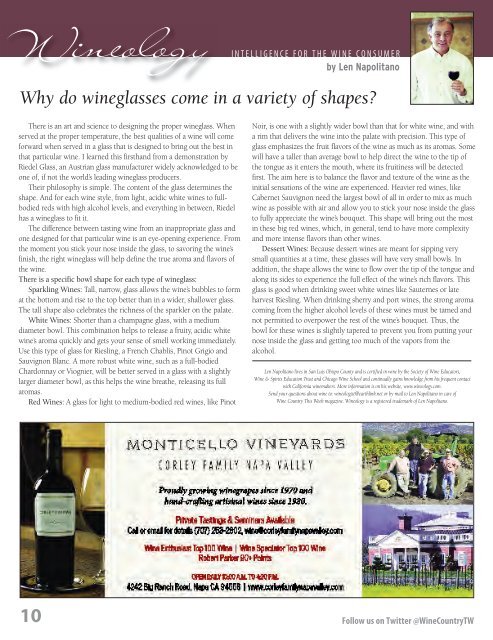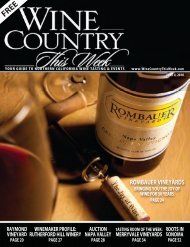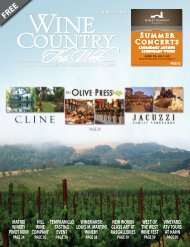View As PDF - Wine Country This Week
View As PDF - Wine Country This Week
View As PDF - Wine Country This Week
Create successful ePaper yourself
Turn your PDF publications into a flip-book with our unique Google optimized e-Paper software.
I N T E L L I G E N C E f O R T H E W I N E C O N S U M E R<br />
by Len Napolitano<br />
Why do wineglasses come in a variety of shapes?<br />
There is an art and science to designing the proper wineglass. When<br />
served at the proper temperature, the best qualities of a wine will come<br />
forward when served in a glass that is designed to bring out the best in<br />
that particular wine. I learned this firsthand from a demonstration by<br />
Riedel Glass, an Austrian glass manufacturer widely acknowledged to be<br />
one of, if not the world’s leading wineglass producers.<br />
Their philosophy is simple. The content of the glass determines the<br />
shape. And for each wine style, from light, acidic white wines to fullbodied<br />
reds with high alcohol levels, and everything in between, Riedel<br />
has a wineglass to fit it.<br />
The difference between tasting wine from an inappropriate glass and<br />
one designed for that particular wine is an eye-opening experience. From<br />
the moment you stick your nose inside the glass, to savoring the wine’s<br />
finish, the right wineglass will help define the true aroma and flavors of<br />
the wine.<br />
There is a specific bowl shape for each type of wineglass:<br />
Sparkling <strong>Wine</strong>s: Tall, narrow, glass allows the wine’s bubbles to form<br />
at the bottom and rise to the top better than in a wider, shallower glass.<br />
The tall shape also celebrates the richness of the sparkler on the palate.<br />
White <strong>Wine</strong>s: Shorter than a champagne glass, with a medium<br />
diameter bowl. <strong>This</strong> combination helps to release a fruity, acidic white<br />
wine’s aroma quickly and gets your sense of smell working immediately.<br />
Use this type of glass for Riesling, a French Chablis, Pinot Grigio and<br />
Sauvignon Blanc. A more robust white wine, such as a full-bodied<br />
Chardonnay or Viognier, will be better served in a glass with a slightly<br />
larger diameter bowl, as this helps the wine breathe, releasing its full<br />
aromas.<br />
Red <strong>Wine</strong>s: A glass for light to medium-bodied red wines, like Pinot<br />
Noir, is one with a slightly wider bowl than that for white wine, and with<br />
a rim that delivers the wine into the palate with precision. <strong>This</strong> type of<br />
glass emphasizes the fruit flavors of the wine as much as its aromas. Some<br />
will have a taller than average bowl to help direct the wine to the tip of<br />
the tongue as it enters the mouth, where its fruitiness will be detected<br />
first. The aim here is to balance the flavor and texture of the wine as the<br />
initial sensations of the wine are experienced. Heavier red wines, like<br />
Cabernet Sauvignon need the largest bowl of all in order to mix as much<br />
wine as possible with air and allow you to stick your nose inside the glass<br />
to fully appreciate the wine’s bouquet. <strong>This</strong> shape will bring out the most<br />
in these big red wines, which, in general, tend to have more complexity<br />
and more intense flavors than other wines.<br />
Dessert <strong>Wine</strong>s: Because dessert wines are meant for sipping very<br />
small quantities at a time, these glasses will have very small bowls. In<br />
addition, the shape allows the wine to flow over the tip of the tongue and<br />
along its sides to experience the full effect of the wine’s rich flavors. <strong>This</strong><br />
glass is good when drinking sweet white wines like Sauternes or late<br />
harvest Riesling. When drinking sherry and port wines, the strong aroma<br />
coming from the higher alcohol levels of these wines must be tamed and<br />
not permitted to overpower the rest of the wine’s bouquet. Thus, the<br />
bowl for these wines is slightly tapered to prevent you from putting your<br />
nose inside the glass and getting too much of the vapors from the<br />
alcohol.<br />
Len Napolitano lives in San Luis Obispo County and is certified in wine by the Society of <strong>Wine</strong> Educators,<br />
<strong>Wine</strong> & Spirits Education Trust and Chicago <strong>Wine</strong> School and continually gains knowledge from his frequent contact<br />
with California winemakers. More information is on his website, www.wineology.com.<br />
Send your questions about wine to: wineologist@earthlink.net or by mail to Len Napolitano in care of<br />
<strong>Wine</strong> <strong>Country</strong> <strong>This</strong> <strong>Week</strong> magazine. <strong>Wine</strong>ology is a registered trademark of Len Napolitano.<br />
10<br />
Follow us on Twitter @<strong>Wine</strong><strong>Country</strong>TW

















